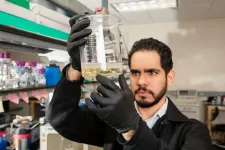(Press-News.org) The Queen Mary-led study reveals the most detailed picture yet of genetic contributors to blood pressure. The findings lead to improved polygenic risk scores, which will better predict blood pressure and risk for hypertension.
Researchers led by Queen Mary University of London and supported by the National Institute for Health and Care Research (NIHR) have discovered over a hundred new regions of the human genome, also known as genomic loci, that appear to influence a person’s blood pressure. In total, over 2,000 independent genetic signals for blood pressure are now reported, demonstrating that blood pressure is a highly complex trait influenced by thousands of different genetic variants.
The study, published in Nature Genetics, is one of the largest such genomic studies of blood pressure to date, including data from over 1 million individuals and laying the groundwork for researchers to better understand how blood pressure is regulated.
To understand the genetics of blood pressure, the researchers combined four large datasets from genome-wide association studies (GWAS) of blood pressure and hypertension. After analysing the data, they found over 2,000 genomic loci linked to blood pressure, including 113 new regions. The analyses also implicated hundreds of previously unreported genes that affect blood pressure. Such insights could point to potential new drug targets, and help to advance precision medicine in the early detection and prevention of hypertension (high blood pressure).
From these analyses, the researchers were able to calculate polygenic risk scores, which combine the effects of all genetic variants together to predict blood pressure and risk for hypertension. For example, these risk scores show that individuals with highest genetic risk have mean systolic blood pressure levels which are ~17 mmHg higher than those with lowest genetic risk, and a 7-fold increased risk of hypertension. Therefore, these polygenic risk scores can discriminate between patients according to their hypertension risk, and reveal clinically meaningful differences in blood pressure.
“We have now revealed a much larger proportion of the genetic contribution of blood pressure than was previously known,” says Helen Warren, Senior Lecturer in Statistical Genetics at Queen Mary University of London and senior last author of the study. “We are making our polygenic risk scores data publicly available. There are many different potential applications of genetic risk scores, so it will be exciting to see how our blood pressure scores can be used to address more clinically relevant questions in the future.”
“This large study builds on over 18 years of blood pressure GWAS research. Our results provide new resources for understanding biological mechanisms and importantly new polygenic risk scores for early identification and stratification of people at risk for cardiovascular diseases” says Patricia Munroe, Professor of Molecular Medicine at Queen Mary University of London, also a senior author of the paper.
Polygenic risk scores have potential to serve as a useful tool in precision medicine, but more diverse genomic data is needed for them to be applicable broadly in routine health care. While the collected data was mostly from people of European ancestry (due to limited availability of diverse datasets when the study was started), the researchers found that the polygenic risk scores were also applicable to people of African ancestry, who have previously been underrepresented in genetic studies. This African ancestry result was confirmed through analysing data from the National Institute of Health’s (NIH) All of Us Research Program in the USA, which aims to build one of the largest biomedical data resources and accelerate research to improve human health.
An estimated 30% of adults in the UK have high blood pressure, known as hypertension. High blood pressure often runs in families, meaning that there is a genetic component to developing the condition in addition to environmental contributions such as a high-salt diet, lack of exercise, smoking and stress. When blood pressure is consistently too high, it can damage the heart and blood vessels throughout the body, increasing a person’s risk for heart disease, kidney disease, stroke and other conditions.
The study combined previously published genetic data from the UK Biobank, a large-scale biomedical database and research resource containing genetic and health information from half a million UK participants (N~450,000 individuals); the International Consortium for Blood Pressure (N~300,000 individuals combined from 77 different cohort studies); and the U.S. Department of Veterans Affairs’ Million Veteran Program (N~220,000 individuals), with new data from Vanderbilt University Medical Center’s biorepository, BioVU (N~50,000 individuals).
The project was led by researchers at Barts NIHR Biomedical Research Centre, Queen Mary University of London, in collaboration with National Human Genome Research Institute (NHGRI) in the USA, Vanderbilt University Medical Center, the University of Groningen in the Netherlands and other institutions, as part of the International Consortium of Blood Pressure. Altogether, over 140 investigators from more than 100 universities, institutes, and government agencies throughout the world contributed to this international study.
END
Researchers identify over 2,000 genetic signals linked to blood pressure in study of over one million people
The Queen Mary-led study reveals the most detailed picture yet of genetic contributors to blood pressure. The findings lead to improved polygenic risk scores, which will better predict blood pressure and risk for hypertension
2024-04-30
ELSE PRESS RELEASES FROM THIS DATE:
Scientists find cancer-like features in atherosclerosis, spurring opportunity for new treatment approaches
2024-04-30
Researchers have discovered that the smooth muscle cells that line the arteries of people with atherosclerosis can change into new cell types and develop traits similar to cancer that worsen the disease. Atherosclerosis is characterized by a narrowing of arterial walls and can increase risk of coronary artery disease, stroke, peripheral artery disease, or kidney disorders. The findings, supported by the National Institutes of Health (NIH), could pave the way for the use of anti-cancer drugs to counteract the tumor-like mechanisms ...
A virus could help save billions of gallons of wastewater produced by fracking
2024-04-30
EL PASO, Texas (April 30, 2024) – An estimated 168 billion gallons of wastewater — or produced water — is generated annually by the Permian Basin fracking industry, according to a 2022 report by the Texas Produced Water Consortium. The major waste stream has proved both difficult and costly to treat because of the chemical complexity of the water.
In a new study published in the journal Water, researchers at The University of Texas at El Paso have identified a novel means of treating the wastewater generated by oil and gas production: bacteriophages.
Ramón Antonio Sánchez, a doctoral candidate within UTEP’s chemistry ...
MSD joins the Open Targets consortium
2024-04-30
Open Targets, a public-private partnership dedicated to pre-competitive drug discovery research, today announced MSD, the tradename of Merck & Co., Inc., Rahway, N.J., USA, as the latest partner to join the consortium. Open Targets aims to accelerate the development of safe and effective medicines by leveraging cutting-edge technologies to identify, prioritise, and validate potential drug targets. MSD’s expertise in drug discovery will complement the strengths of the current partners: EMBL’s European Bioinformatics Institute (EMBL-EBI), the Wellcome Sanger Institute, GSK, Sanofi, Pfizer, and Genentech, ...
U of T researchers target neurogenesis in new approach to treat Parkinson’s disease
2024-04-30
Researchers at the University of Toronto have found a way to better control the preclinical generation of key neurons depleted in Parkinson’s disease, pointing toward a new approach for a disease with no cure and few effective treatments.
The researchers used an antibody to selectively activate a receptor in a molecular signaling pathway to develop dopaminergic neurons. These neurons produce dopamine, a neurotransmitter critical to brain health.
Researchers around the world have been working to coax stem cells to differentiate into dopaminergic ...
Microbiome researchers challenge the state of the art in colon cancer biomarker discovery
2024-04-30
Leuven (Belgium) 30/04/2024 - For the first time, researchers from VIB-KU Leuven, UZ Leuven, Janssen Pharmaceutica and multiple international collaborators have introduced quantitative methods and extensive confounder control to discover microbiome biomarkers in colorectal cancer development. While multiple microbial taxa have been put forward as potential cancer-associated biomarkers in the past, this new study uncovers obscured contributions that may have resulted in incorrect associations. The results have been published in Nature Medicine.
Cancer ...
Unveiling nature's custodians: groundbreaking study highlights crucial role of scavengers in wetlands
2024-04-30
A pioneering study highlights the importance of carrion and scavengers in wetlands on a global scale. A study by researchers from the Ecology area of the Miguel Hernández University of Elche (UMH) and the Ecology department of the University of Alicante (UA) reveals the fundamental importance of scavengers and carrion in wetlands. The article, published in Biological Reviews, emphasizes that the benefits provided by scavengers far outweigh the potential drawbacks. Among their essential functions are the recycling and transportation of nutrients and the regulation of water quality, benefiting the entire ecosystem, from soil and plants to birds and mammals.
Historically, ...
Data scarcity challenges identification of endocrine disruptors
2024-04-30
As a result, the researchers recommend updating the information requirements in the EU legislation, REACH. They also propose various approaches for evaluating chemical substances to ensure that all available information is fully utilized.
Researchers from DTU National Food Institute and the University of Southern Denmark have screened the scientific literature for the Danish Environmental Protection Agency to find substances showing signs of endocrine disrupting properties and thus being potentially harmful to humans and ...
A significant portion of the world’s population continues to trust vaccines, says survey in 23 countries
2024-04-30
A substantial proportion of the world’s population remains willing to get vaccinated against diseases including COVID-19, according to a new survey across 23 countries that represent more than 60% of the world’s population. The study, published in Nature Medicine, was co-led by the Barcelona Institute for Global Health (ISGlobal), a centre supported by “la Caixa” Foundation, and the Graduate School of Public Health and Health Policy of the City University of New York (CUNY SPH).
The severe human impact of the COVID-19 pandemic led to the rapid research and development of safe and effective vaccines based on existing models, ...
Clumps of this molecule inhibit strep’s DNA-cleaving enzymes
2024-04-30
An entirely new approach to inhibiting DNA-cleaving enzymes works through the aggregation of an otherwise non-toxic molecule. This Kobe University discovery may lead to a much-needed method for curbing Streptococcus growth.
Enzymes are the body’s tools to make almost all reactions happen. But the same is true for bacteria like Streptococcus, which causes toxic shock syndrome, a rapidly progressing and deadly condition. When the body’s white blood cells try to capture the bacteria by casting nets made out ...
Cars as particles
2024-04-30
What do the flow of cars on a highway and the movement of bacteria towards a food source have in common? In both cases, annoying traffic jams can form. Especially for cars, we might want to understand how to avoid them, but perhaps we've never thought of turning to statistical physics, as Alexandre Solon, a physicist from Sorbonne Université, and Eric Bertin, from the University of Grenoble, both working for the Centre national de la recherche scientifique CNRS, have done. Their research, recently published in the Journal of Statistical Mechanics: Theory and Experiment (JSTAT), has developed a one-dimensional mathematical model ...
LAST 30 PRESS RELEASES:
Next-generation vision model maps tree growth at sub-meter precision
Genes aren’t destiny for inherited blindness, study shows
MIT study: High-fat diets make liver cells more likely to become cancerous
Exposure to multiple fine particulate matter components and incident depression in the US Medicare population
Risk of burdensome health care spending over time in the US
Nirsevimab against hospitalizations and emergency department visits for lower respiratory tract infection in infants
New microfluidics technology enables highly uniform DNA condensate formation
A new strategy for immune tolerance
Super Mario Bros. help fight burnout: New study links classic games to boosted happiness
Deepest gas hydrate cold seep ever discovered in the arctic: International research team unveils Freya Hydrate Mounds at 3,640 m depth.
Integrating light and structure: Smarter mapping for fragile wetland ecosystems
ACA-SIM: A robust way to decode satellite signals over complex waters
Probiotics can restore gut microbiome in breastfed infants
AI could help predict nutrition risks in ICU patients, study finds
Federal EITC has unexpected result, researchers say – it decreases domestic violence
Researchers identify gene that calms the mind and improves attention in mice
Artificial metabolism turns waste CO2 into useful chemicals
Ancient sea anemone sheds light on animal cell type evolution
Begging gene leads to drone food
How climate policies that incentivize and penalize can drive the clean energy transition
Can community awareness campaigns in low-resource areas improve early diagnosis of colorectal cancer?
Stardust study resets how life’s atoms spread through space
Practical education: Clinical scenario-based program development
The impact of family dynamics on eating behaviour – how going home for Christmas can change how you eat
Tracing the quick synthesis of an industrially important catalyst
New software sheds light on cancer’s hidden genetic networks
UT Health San Antonio awarded $3 million in CPRIT grants to bolster cancer research and prevention efforts in South Texas
Third symposium spotlights global challenge of new contaminants in China’s fight against pollution
From straw to soil harmony: International team reveals how biochar supercharges carbon-smart farming
Myeloma: How AI is redrawing the map of cancer care
[Press-News.org] Researchers identify over 2,000 genetic signals linked to blood pressure in study of over one million peopleThe Queen Mary-led study reveals the most detailed picture yet of genetic contributors to blood pressure. The findings lead to improved polygenic risk scores, which will better predict blood pressure and risk for hypertension







